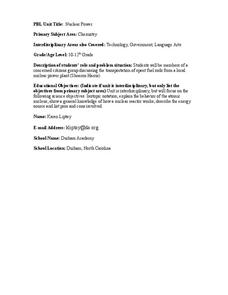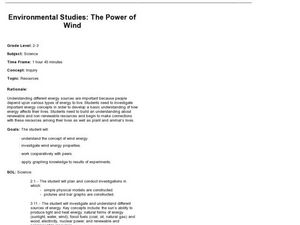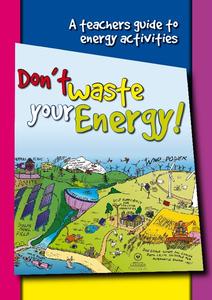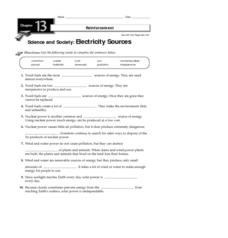Curated OER
US Energy Geography
The maps display the statistics for energy consumption and power production, state by state. They are tremendous visual aids for your natural resources unit. Consider having your class compare energy consumption versus production, or...
Curated OER
Mining Uranium and Nuclear Reactor
In this mining worksheet, students fill in the blanks to paragraphs about mining uranium and a nuclear reactor. Students fill in the blanks for 17 sentences.
Curated OER
Nuclear Power
Students take on the role of members of a concerned citizens group and discuss the transportation of spent-fuel rods from a local nuclear power plant and the safety issues that surround the power plant. Students work in groups to write...
Curated OER
Nuclear Energy
Atomic theory as a philosophical study was explored even by the Ancient Greeks. The knowledge of atoms was developed in the 17th century. This PowerPoint explains how by the 1940's, splitting of the atom was discovered and since then,...
Carnegie Mellon University
Understanding Electricity Mix Tradeoffs
Use the accompanying presentation and colorful technology sheets to introduce your class to the 10 different energy technologies. Connect kids to an interactive computer tool that allows them to combine different types of power...
Curated OER
Nuclear Energy
Brightly colored graphics are interspersed among slides in an attempt to add visual appeal, but the core of this collection comes more from informational content, mostly the history of nuclear energy. The safety of using nuclear reactors...
Science Geek
Nuclear Chemistry
Which bichemicals wash up on shore? Nucleotides! Presentation covers alpha, beta, and gamma radiation. Includes a comparison of fission versus fusion. Presentation is the second in a five-part series.
It's About Time
What Determines and Limits an Atom's Mass?
Provide learners with the tools to further understand nuclear energy and isotopes. Young chemists investigate the components of an atom's nucleus, use symbols to represent various isotope forms, and use the percent abundance of an atom's...
Curated OER
Breaking News: Second Explosion at Japan Nuclear Plant (14th March, 2011)
Students explore current events by sharing information about the Japanese nuclear plant. In this nuclear energy lesson, students discuss the pros and cons of nuclear energy plants and whether or not they can typically withstand natural...
Curated OER
Environmental Studies: The Power of Wind
Investigate the prospect of wind as a renewable resource. Second and third graders make a pinwheel, answer critical thinking questions, and then attempt to use wind power to wind string. I would be more apt to use this lesson in a 1st or...
Carnegie Mellon University
How Power Plants Work 1
First of three lessons, this is a great start to a unit on energy. As you demonstrate, learners discover different types of energy and how it is converted from one form to another. They then focus in on the generation of electricity by...
Government of South Australia
Don't Waste Your Energy
Don't lift another finger, this physical and environmental science unit has everything you need to begin teaching your class about energy. Starting with a look at the greenhouse effect, these lessons and activities take young scientists...
Curated OER
Poster Presentations
Students create visual displays explaining how nuclear power is used to produce electricity. They create a display board that shows the chain reaction, the fission process, and a schematic diagram of the reactor.
Curated OER
German Energy Conversations
High schoolers identify and interpret the current German energy mix and trends, as well as to make comparisons and contrasts to that of their own country. They write a two paragraph description of including its likely position in the...
Curated OER
Nuclear Power
In this nuclear power worksheet, students compare fission and fusion. Students learn about the different kinds of radiation. This worksheet has 2 short answer questions and 10 matching questions.
Curated OER
Radioactive Simulations
Students simulate radioactive decay and nuclear power using an on line interactive web site. In this on line lesson plan, students monitor radioactive isotopes and record the activity of a particular element as the decay progresses. They...
Curated OER
Nuclear Waste
Students identify pros and cons of nuclear power, and analyze problems surrounding nuclear waste and how to make decisions regarding its disposal.
Curated OER
Electricity Sources
In this electricity worksheet, students review the different types of energy sources including fossil fuels, solar, wind, and nuclear energy. This worksheet has 10 fill in the blank questions.
Carnegie Mellon University
How Power Plants Work 2
For this second of three lessons on power plants, future engineers find out how we generate electricity and how coal-powered plants operate. They work in small groups to make electromagnet generators to light LED bulbs. A set of...
Curated OER
Science Safari: Energy Resources
Learners discover how scientific methods are integral to the creation of energy. In this energy resources lesson, students follow the provided procedures to learn how science impacts energy production.
National Institute of Open Schooling
Radioactive Pollution
Radioactive pollutants can enter the body through ingestion, inhalation, absorption, or injection. The last lesson in a series of 36 introduces pupils to radioactive pollution. They study its sources, both natural and man-made, its...
Society of Petroleum Engineers
Renewable and Nonrenewable Energy
Energize an environmental science unit on natural resources with this collection of instructional materials. From simple coloring sheets for primary grade children, to guiding questions for a high school research report, a wide variety...
Curated OER
Half Lives
Students investigate the concept of half-life by conducting an M&M experiment. In this chemistry lesson, students differentiate nuclear fusion and fission. They present investigation findings to class.
Curated OER
We've Got the Power
Middle schoolers examine how power can be generated and the advantages and disadvantages of each method. In this investigative lesson students divide into groups, research the Internet and present it to the class.

























